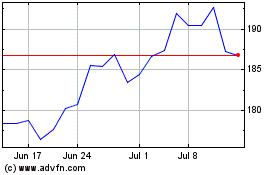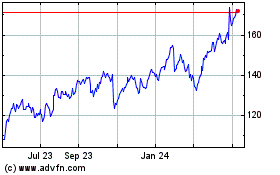By Mike Spector
Last October, Tesla Motors Inc. Chief Executive Elon Musk
heralded the arrival of the company's autonomous-driving
technology, inviting owners of its electric cars to download
software allowing its cars to operate themselves under certain
conditions.
His message to owners on its website: "Your Autopilot has
arrived."
Nine months later, the National Highway Traffic Safety
Administration may have its first substantive chance to weigh in on
whether the system is fit for U.S. roads.
While the auto-safety agency has been an advocate of many of the
technologies Tesla uses for its Autopilot system, it had virtually
no power to stop or impose requirements on how the auto maker
released it. NHTSA's decision to open an initial investigation into
a fatal May crash of a Tesla Model S using Autopilot gives it the
first chance to flex regulatory muscle.
The crash, which killed motorist Joshua Brown, is the first
known fatality connected to Tesla's autonomous-driving system.
Autopilot technology has been used in thousands of Tesla sedans and
SUVs on American roads since October, but regulators until now had
left it to Tesla and its car owners to use the system
responsibly.
U.S. officials are currently powerless to approve or disapprove
advanced systems such as Tesla's Autopilot unless they run afoul of
regulations that address car steering wheels, brakes and seat belts
designed for human operators. Unlike the U.S. Food and Drug
Administration, which approves drugs and devices meant to save
lives, NHTSA's oversight is often reactive.
"NHTSA has no premarket regulatory authority," David Strickland,
a former agency head who now represents auto makers pursuing
driverless technologies at law firm Venable LLP, said on Friday.
"The only thing the agency can do is make a decision whether the
vehicle is noncompliant with the existing federal motor vehicle
safety standards."
To date, few such standards exist for autonomous or
semiautonomous vehicles, like the Model S. Tesla tweaked the system
earlier this year after drivers posted YouTube videos of themselves
engaging in dangerous behaviors such as reading a newspaper while
the system was engaged, and took several steps to warn drivers to
remain alert and ready to intervene while behind the wheel.
Regulators are preparing to release guidelines for automated
vehicles in July that attempt to balance adoption of promising
technologies while ensuring they're safe. Companies developing
driverless cars -- including Alphabet Inc.'s Google and Tesla --
have expressed reservations about the regulatory oversight,
contending it could delay widespread deployment. But they support
general guidelines that aim to avoid conflicting rules when cars
drive themselves across state lines.
NHTSA officials are discussing steps that include developing new
safety standards that driverless-car systems must meet; steering
auto makers toward potential third-parties to certify technologies;
and seeking congressional authority to approve such systems, said a
person familiar with the matter. But regulators share industry
concerns that undertaking new rules or legislation could take
years, prolonging limited oversight of driverless-car features or
resulting in new policies that are soon eclipsed by the latest
technological developments.
The upshot is the July guidelines will lack authority when it
comes to oversight of the new technologies being introduced in new
cars and light trucks. The agency hasn't made any final decisions
on the coming guidelines, which aim to make recommendations for
states and other local governments to avoid conflicting patchworks
of rules across the U.S.
The circumstances surrounding Mr. Brown's accident also raise
questions about NHTSA's ability to make immediate changes. While
the Autopilot system didn't detect an truck making a left turn in
front of Mr. Brown's Tesla, there is evidence suggesting he was
also not paying attention.
The truck driver involved in the collision said he believed Mr.
Brown was watching a movie at the time of the wreck. Police found a
portable DVD player in the Tesla car but haven't confirmed whether
it was on during the crash, said Florida Highway Patrol Sgt. Kim
Montes.
Tesla, while expressing condolences to Mr. Brown's family and
friends, said the death represented the first in more than 130
million miles driven with the system activated. The Palo Alto,
Calif., company said it immediately alerted regulators to the
incident.
A NHTSA spokesman declined to comment.
Some feel regulators could have moved faster once the YouTube
videos emerged. "Those should have been key markers for the
agency," said Sean Kane, founder of consulting firm Safety Research
& Strategies Inc., who has advised lawyers in lawsuits against
auto makers, though not Tesla. He added that car-safety regulators
are often outgunned and outspent by auto makers.
NHTSA officials have become more proactive policing auto makers
since a new chief, Mark Rosekind, took the helm at the end of 2014
amid widespread criticism that the agency missed safety problems
including faulty ignition switches in older General Motors Co. cars
now linked to 124 deaths.
With driverless cars, the agency has cited potential conflicts
with existing regulations, such as with a future vehicle that
doesn't employ physical brakes. NHTSA officials have said they
would consider waiving certain existing rules in isolated cases if
auto makers can demonstrate technologies have significant safety
benefits.
NHTSA officials earlier this year said a computer could be
considered a driver for regulatory purposes in response to a query
from Google, which is racing to develop fully autonomous cars. But
U.S. Transportation Secretary Anthony Foxx attempted to temper the
finding by emphasizing that "the burden remains on self-driving car
manufacturers to prove that their vehicles meet rigorous federal
safety standards."
Transportation Department inspector general audits released in
the past 18 months faulted regulators for relying too much on auto
makers to report safety problems, lapses screening and documenting
consumer complaints and lagging training for employees. The agency
pledged to follow recommendations in the reports.
NHTSA, meanwhile, also found room for improvement, including
putting auto makers on notice over safety issues even when they
lack evidence to open formal investigations.
(END) Dow Jones Newswires
July 01, 2016 15:55 ET (19:55 GMT)
Copyright (c) 2016 Dow Jones & Company, Inc.
Alphabet (NASDAQ:GOOG)
Historical Stock Chart
From Mar 2024 to Apr 2024

Alphabet (NASDAQ:GOOG)
Historical Stock Chart
From Apr 2023 to Apr 2024
